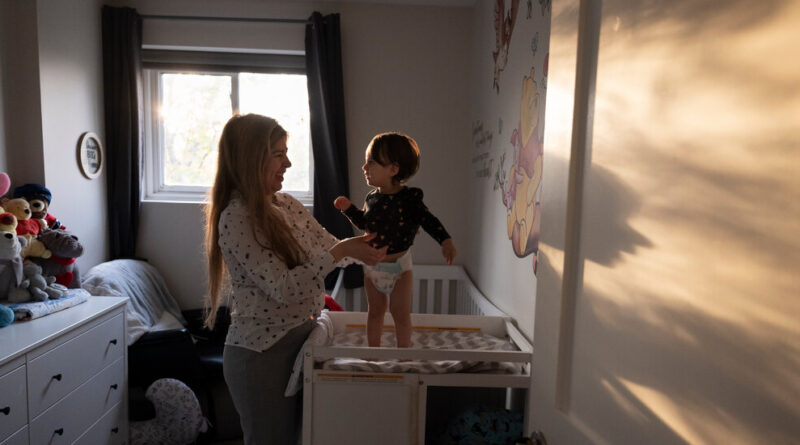Day Care for Less Than $10: How Canada Is Easing the Burden for Parents
[ad_1]
As Susana Ibarra’s maternity leave was ending and she was preparing to return to her office outside Toronto, she still faced a big challenge: finding care for her son and then figuring out how to pay for it.
Finally, after putting him on a dozen or so waiting lists, she landed a spot. Even better, it came at a discounted fee of 600 Canadian dollars, or $450, a month.
The low cost was the result of an ambitious day care plan expanding across Canada, intended to drastically cut fees that supporters say will address one of the most vexing problems facing many working parents.
“It was just perfect timing,” said Ms. Ibarra, who in January went back to work as a paralegal at a tax services firm in Mississauga, a Toronto suburb. She had heard plenty of stories of co-workers who stopped working once they had children because child care costs were exorbitant.
The national day care plan was introduced two years ago by Prime Minister Justin Trudeau’s government with a goal of steadily pushing down child care costs so that, by 2026, tens of thousands of child care slots would be available at daily fees of 10 Canadian dollars, roughly 200 dollars a month, or less.
By comparison, in large urban areas like Toronto or Vancouver, day care can cost 1,200 Canadian dollars or more per month, or about 60 dollars a day.
The federal child care program is “a transformative project on a scale with the work of previous generations of Canadians, who built a public school system and public health care,” the federal government said in a statement when the program was unveiled.
Working with the country’s provinces, which are responsible for delivering education and child care services, the federal government plans to spend up to 30 billion Canadian dollars to create a total of 250,000 new low-cost child care spaces, mostly in nonprofit or public day care centers and family-based providers.
Child care providers use government financing to reduce their fees over time until they reach the 10 Canadian dollars a day threshold.
Day care centers in five of Canada’s 13 less populated provinces and territories have already lowered fees to that level, while the remaining provinces, including Ontario, have cut their fees by half on the road to reaching 10 dollars per day.
So far, about 52,000 reduced-cost child care slots have been created across the country under the program.
“This is part of our plan to make life more affordable for the middle class and for people working hard to join it,” Mr. Trudeau said in March while announcing the program’s expansion in Manitoba.
Though the program has been widely praised, it has run into growing pains with demand for discounted child care slots exceeding supply and providers grappling with a shortage of workers.
Making child care more affordable enables many working parents, especially women, not to have to choose between their careers or raising their children, child care advocates and researchers said. Studies have also shown that low-cost child care is an economic boon because it increases the work force participation of women.
“Not only is this really good for our economy, not only is this really good for gender equality and for women in the work force, but it’s also really good for setting up our kids for success,” said Karina Gould, Canada’s minister of families, children and social development.
Among the world’s wealthiest countries, European nations tend to dominate rankings of child care policies.
A Unicef report two years ago that measured maternity leave and day care costs, among other factors, showed that nine of the top 10 nations were in Europe, led by Luxembourg. (Canada ranked 22nd, while the United States, which spends far less on child care than most other wealthy nations, was 40th.)
Rosanne D’Orazio and her husband moved more than a decade ago from Montreal to Iqaluit, the capital of the sparsely populated northern Canadian province of Nunavut, where she said day care consumed a large chunk of her pay working for an Inuit association.
But last December, the child care fee for her 3-year-old daughter dropped to 10 dollars a day after day care centers in the province started lowering prices as part of the federal program.
Ms. D’Orazio, who also has a son, 7, and whose husband is a freelance photographer and videographer, decided to switch careers.
Having monthly day care reduced to 200 Canadian dollars from 1,500 dollars “allowed me the flexibility, the financial freedom,” she said, “to leave my nine-to-five and become a consultant” to Indigenous organizations.
Canada’s program was modeled, in part, after a similar initiative in Quebec that started 25 years ago. Parents there pay around 9 Canadian dollars a day for government-subsidized day care.
Supporters say the program has allowed more women to work. Nearly 90 percent of women in Quebec are in the work force, the highest labor participation rate among women of any Canadian province.
The program has also strengthened the province’s economy: Quebec’s gross domestic product is 1.5 percent higher than it would have been without the program, according to research by Pierre Fortin, an emeritus professor of economics at the Université du Québec à Montréal.
“We certainly know that there’s strong benefits for families and there’s benefits for the economy, so that’s what’s been able to convince the Canadian government that it should follow the Quebec example,” said Gordon Cleveland, an emeritus professor in economics at the University of Toronto, who has advised the federal government on its child care program.
One of the biggest challenges facing child care providers that are part of the federal program is accommodating parents seeking to enroll.
“I knew that the parents that I serve would need this program,” said Susie Beghin, the owner of Alpha’s Discovery Kids, which operates three day care centers in what she described as working-class communities outside Toronto.
The centers serve 270 children and have a monthslong waiting list of parents seeking a discounted slot.
The surge in demand has amplified existing problems across Canada’s child care sector, including labor shortages and concerns about low pay. Some critics worry that the Trudeau government is investing a significant amount of money in a program that will serve a relatively small number of children.
Others say more parents would benefit if the government instead expanded existing child care tax breaks.
“Despite the best intentions of the federal program, I’m concerned it’s going to entrench an expensive, poor quality program that serves a minority of children” and underestimates the cost and complexity of delivering child care, said Peter Jon Mitchell, director of the family program at Cardus, a research group.
Some day care providers say the program has made it harder to raise wages because once they receive government funds, they cannot raise their fees, and federal financing does not cover all their expenses.
“That has limited the capacity of existing programs and it has also made expansion pretty much impossible,” said Morna Ballantyne, the executive director of Child Care Now, an advocacy group. “You just can’t run programs without staff and you can’t run quality programs without qualified staff.”
But for many families, the low-cost day care program has been a welcome relief.
Ms. Ibarra, whose partner works as a delivery driver, had been ready to spend as much as 1,300 Canadian dollars, or $970, a month for her 18-month-old son, Ethan, the regular fees at the day care where he is enrolled.
Paying around 600 dollars a month, she said, “made going back to work a very easy choice” and has allowed her to build up her savings.
Roopal Khandelwal moved from Delhi to Toronto in February when her husband got a new position at his company. They have a 2-year-old son, Avik, and are expecting a second child in August.
Finding a discounted day care slot for Avik means that Ms. Khandelwal, 32, a digital marketing specialist, can return to work.
“I do have a big break of two years in my résumé,” Ms. Khandelwal said. “I am looking forward to giving a fresh start to my career.”
[ad_2]
Source link



